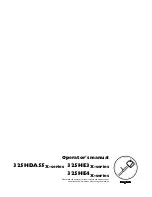
Safety
English
7
4
Cutting procedures
a)
DANGER: Keep hands away from cutting
area and the blade. Keep your second hand on
auxiliary handle, or motor housing.
If both hands are
holding the saw, they cannot be cut by the blade.
b)
Do not reach underneath the workpiece.
The
guard cannot protect you from the blade below the
workpiece.
c)
Adjust the cutting depth to the thickness of the
workpiece.
Less than a full tooth of the blade teeth
should be visible below the workpiece.
d)
Never hold the workpiece in your hands or
across your leg while cutting. Secure the
workpiece to a stable platform.
It is important to
support the work properly to minimize body exposure,
blade binding, or loss of control.
e)
Hold the power tool by insulated gripping
surfaces, when performing an operation where the
cutting tool may contact hidden wiring or its own
cord.
Contact with a "live" wire will also make exposed
metal parts of the power tool "live" and could give the
operator an electric shock.
f)
When ripping, always use a rip fence or straight
edge guide.
This improves the accuracy of cut and
reduces the chance of blade binding.
g)
Always use blades with correct size and shape
(diamond versus round) of arbour holes.
Blades that
do not match the mounting hardware of the saw will run
off-centre, causing loss of control.
h)
Never use damaged or incorrect blade washers
or bolt.
The blade washers and bolt were specially
designed for your saw, for optimum performance and
safety of operation.
5 Lower guard function
a)
Check the lower guard for proper closing before
each use. Do not operate the saw if the lower guard
does not move freely and close instantly. Never
clamp or tie the lower guard into the open position.
If the saw is accidentally dropped, the lower guard may
be bent. Raise the lower guard with the retracting
handle and make sure it moves freely and does not
touch the blade or any other part, in all angles and
depths of cut.
b)
Check the operation of the lower guard spring. If
the guard and the spring are not operating
properly, they must be serviced before use.
Lower
guard may operate sluggishly due to damaged parts,
gummy deposits, or a build-up of debris.
c)
The lower guard may be retracted manually only
for special cuts such as "plunge cuts" and
"compound cuts". Raise the lower guard by the
retracting handle and as soon as the blade enters
the material, the lower guard must be released.
For
all other sawing, the lower guard should operate
automatically.
d)
Always observe that the lower guard is covering
the blade before placing the saw down on bench or
floor.
An unprotected, coasting blade will cause the
saw to walk backwards, cutting whatever is in its path.
Be aware of the time it takes for the blade to stop after
switch is released.
6 Power tool use and care
a)
Do not force the power tool. Use the correct
power tool for your application.
The correct power
tool will do the job better and safer at the rate for which
it was designed.
b)
Do not use the power tool if the switch does not
turn it on and off.
Any power tool that cannot be
controlled with the switch is dangerous and must be
repaired.
c)
Disconnect the plug from the power source
and/or remove the battery pack, if detachable, from
the power tool before making any adjustments,
changing accessories, or storing power tools.
Such
preventive safety measures reduce the risk of starting
the power tool accidentally.
d)
Store idle power tools out of the reach of
children and do not allow persons unfamiliar with
the power tool or these instructions to operate the
power tool.
Power tools are dangerous in the hands of
untrained users.
e)
Maintain power tools and accessories. Check for
misalignment or binding of moving parts, breakage
of parts and any other condition that may affect the
power tool’s operation. If damaged, have the power
tool repaired before use.
Many accidents are caused
by poorly maintained power tools.
f)
Keep cutting tools sharp and clean.
Properly
maintained cutting tools with sharp cutting edges are
less likely to bind and are easier to control.
g)
Use the power tool, accessories and tool bits
etc. in accordance with these instructions, taking
into account the working conditions and the work
to be performed.
Use of the power tool for operations
different from those intended could result in a
hazardous situation.
h)
Keep handles and grasping surfaces dry, clean
and free from oil and grease.
Slippery handles and
grasping surfaces do not allow for safe handling and
control of the tool in unexpected situations.
i)
Do not use damaged or faulty blades or blade
flanges.
Blade flanges and nuts are custom made for
this tool to ensure optimum operating performance and
safety.
7 Service
Have your power tool serviced by a qualified repair
center using only identical replacement parts.
This
will ensure that the safety of the power tool is
maintained.


































